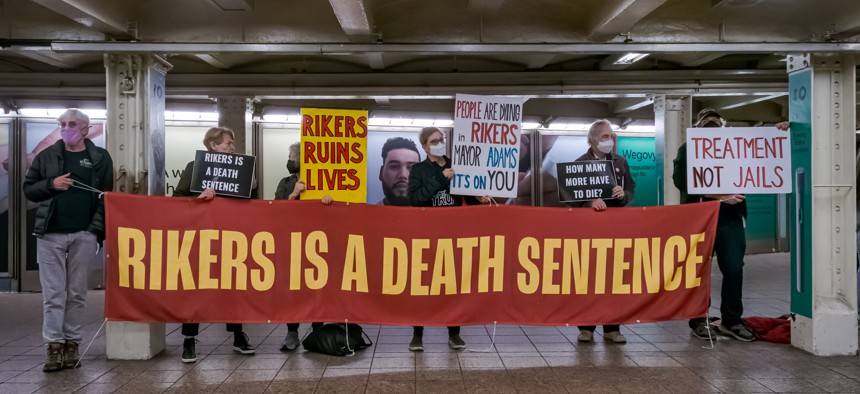Editor's Note
Editor's Note: How many more will die at Rikers?
The city keeps sending people to the infamous jail complex, and people keep dying.

Members of the activist group Rise and Resist hold a banner in the Times Square subway station during the Close Rikers Vigil on April 3, 2023. Erik McGregor/LightRocket via Getty Images
When the first jail opened on Rikers Island in 1935, The New York Times heralded it as an “ultra-modern penitentiary” complete with its own hospital and auditorium for movie nights, favorably contrasting it with the “almost medieval cell blocks of the old prison” that it replaced. Nearly a century later, Rikers has become its own kind of dungeon, holding thousands of prisoners awaiting trial, some in torturous solitary confinement conditions.
It’s a place where parents awaiting trial have few opportunities to see their own children, where people die in hospital prison wards and their families are left to pick up the pieces.
The true number of deaths in the city jails system is unknown. A comprehensive investigation for City & State by Kelly Grace Price, who herself was once incarcerated on Rikers, found that at least 120 people have died in the city’s jails system since 2014. Not all of those deaths were recorded by the city Department of Correction and many were never disclosed to the public or the press. (In a sign of how common death is in city jails, the print version of this week’s issue of City & State magazine reports that 119 people have died since 2014. That’s because it was sent to the printers on Friday evening, before the most recent death at Rikers occurred on Sunday morning.)
Can anything be done to solve Rikers? City & State asked an array of experts to weigh in, and their prescriptions ranged from decreasing the number of people held at Rikers to shutting it down entirely.
Former Mayor Bill de Blasio backed a plan to close the Rikers jails complex and replace it with four smaller jails in Manhattan, Brooklyn, Queens and the Bronx by 2027. By design, the four borough-based jails have smaller capacity than the sprawling Rikers Island complex; the plan is meant to spur “decarceration,” or jailing fewer people. (A small but growing contingent of abolitionists are pushing to go even further, to shut down Rikers but not build any new jails.)
For the borough-based jails plan to work, the city must reduce Rikers’ population to about 3,300 people, the number of people who can be held in all four borough-based jails. Without a serious commitment from prosecutors and judges to stop sending people to jail before trial, it’s hard to see how that could be achieved.
As of Monday Rikers held 6,239 people, according to the city Department of Correction. In light of the large number of people detained at Rikers, the city announced last week that the new Brooklyn jail will house 150 more detainees than originally planned. Mayor Adams is less committed to closing Rikers than de Blasio was. He has said that he has no plans to reduce the jail population to just 3,300 people and has called for the borough-based jails plan to be reexamined.
In the end, the city may not get to decide the fate of the jails complex. In a court hearing last week, federal judge Laura Taylor Swain said that ongoing issues at Rikers could make it necessary for a federal receiver to assume control of the jail.

